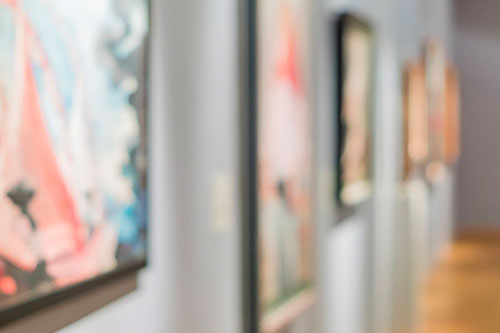Galleries
Showcasing student and community artwork

Besse Gallery
The Besse Center South Gallery is located at the entrance to the Learning Resource Center. This gallery houses the college's permanent art collection, as well as exhibits of local and national artists. Each semester a student exhibit features a wide variety of drawing, painting, ceramics, photography and mixed media.
Robert Addison’s 100th Birthday Celebration

El Track. Robert William Addison.
Please join us in celebrating the life and works of Robert Addison. We will also be auctioning off three reproductions of his work at the event.
The late Robert William Addison, a Chicago-based artist for over 40 years. Born on January 17, 1924, in Boise, Idaho, Mr. Addison originally intended to become an architect. Fortunately for the art world, his plans were sidetracked when he joined the Army right out of high school. After suffering an injury during training, he spent his recovery time painting. The Red Cross sponsored a show of his works, where all his paintings were sold, providing him with the confidence to pursue a career as an illustrator.
Fate intervened again in 1948, as post-war America saw an influx of aspiring illustrators. With classes filled, Mr. Addison turned to the School of the Art Institute of Chicago, where he intensified his commitment to fine art. Encouraged by his teacher, Paul Wiegard, he was introduced to the Dutch and Italian Renaissance masters he came to admire, especially Bernardo Bellotto. Bellotto's scenes, characterized by topographical precision and architectural detail, would inspire Mr. Addison's own work.
Intrigued by Mr. Addison’s dedication to realism during a time when abstraction was in vogue, Wiegard provided individual instruction three days a week, challenging him to study the technical excellence of the masters. During his time at the Art Institute, Mr. Addison realized he could organize his artistic gifts with such virtuosity that he could imitate any past painting style or expression, including those of the master’s he admired. However, he believed these artists had exhausted their respective forms in ways appropriate to their times.
Of the hundreds of paintings Mr. Addison created over the course of his distinguished career, there are certain pieces that are considered benchmarks: works in which he achieved some type of breakthrough in the development of his painting technique. El Tracks is certainly one of them. Another is The Children are Gone (1955) a rendering of carousel horses placed in a deserted setting in which an almost surrealistic quality of timelessness exists within reality. The horses appear at once sad and lonely, yet they are also slightly menacing and eerie; two levels of consciousness balanced within each other. This is a characterization the artist brilliantly conveyed time and again. Many of his works operated on dual levels – loneliness and warmth, familiarity with solitude combining to create the haunting quality that was his trademark. It was Mr. Addison’s mastery of mood, spatial vision and light that was responsible for drawing viewers deep into his paintings, never allowing for a stop at first glance – compelling, almost demanding, deeper inspection of the work, literally inviting the viewer to experience the image.
Hartwig Gallery
The Bay College Hartwig Art Gallery opened in January, 2000, in conjunction with the new art wing, which houses the college’s art studios for ceramics, painting, and drawing. Gallery shows feature the best artists from the upper Midwest region, and change throughout the year. At the end of each semester the Art Students Show displays award-winning art students’ work--the best of these are awarded purchase prizes and become part of Bay’s permanent Art Collection.
Amber Dohrenwend "Permission Machine"

Finding Myself Again. Amber Dohrenwend.
Amber Dohrenwend is a visual artist based in Marquette, Michigan. She creates sculptures, installations and assemblages with soft, organic curves and textures, made primarily from cast-off cardboard. The humble quality of the materials she utilizes serve to aid her in the exploration of themes surrounding community, connection and transformation. Her work directs viewers’ attention to the under-recognized value of both relationships and material. She often works with nothing more than cardboard, a pair of scissors and a stapler.
For more than a decade now, I have explored cardboard as a medium. I used to collect cardboard each week when my neighbors set out their weekly recycling, and I started making cardboard furniture, toys, and Halloween costumes for my children when they were young. I loved making things for them. It felt like something a mother should delight in and I very much did. As my relationship to the material grew and so did my skill, I remember reaching a point when I felt I had something to say about cardboard as a medium. I also felt I had many things to say by communicating through it. What was difficult for me at that point was making art for art’s sake. I didn’t think I had any business doing it. I was fortunate to be encouraged and given opportunities to make work by many people who intuitively understood what I wanted to do but saw that I lacked confidence. During that time, I would often host pop-up cardboard play-days and workshops for children because I felt more comfortable giving permission to them to play rather than giving permission to myself to create. Permission Machine showcases a body of work that was made while reflecting on these ideas. I wanted to give form and shape to these “permission machines” that have both helped and hindered me in my journey as an artist. I hope the viewer may similarly reflect on permission structures ….and how we can be conscious of their power to shape both our creative life and spirit.
On Campus
Contact
Kristine Granger
Visual Arts Instructor/Coordinator
CB 200A
906-217-4252
Email Kristine